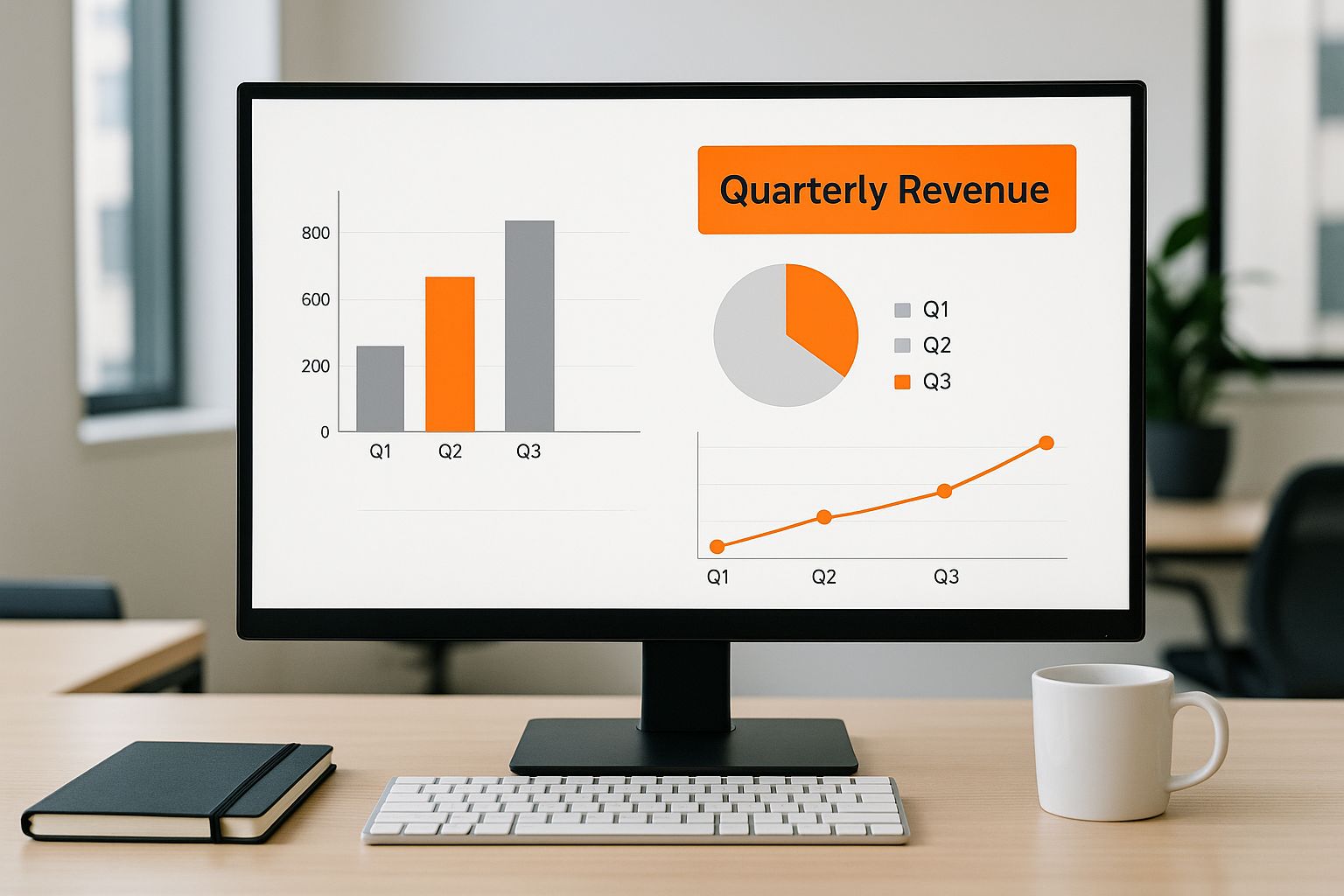A good quarterly review template isn't just a document. It’s a complete system for making sharp, data-backed decisions that push your business ahead. Think of it as the framework that turns all your hard work over the past 90 days into real, measurable progress and crystal-clear goals for the next quarter.
Why a Quarterly Review Is Your Secret Weapon for Growth
Let's get real for a second. Most "reviews" are a total drag. They often devolve into a backward-looking exercise of pointing fingers or patting backs, and rarely lead to any meaningful change. A proper, structured quarterly review is the polar opposite. It's a forward-looking process that connects your team’s day-to-day grind to the bigger picture.
This strategic rhythm forces you to hit pause, take a hard look at the data, and adapt every three months. That frequency is key. Things move way too fast these days for annual planning to be your only North Star. Quarterly check-ins give you the agility to pivot based on what's happening right now, snuff out small problems before they become massive headaches, and pour more fuel on what's already working.
This isn't some new-age business trend; it's a battle-tested management practice. The move to structured quarterly reviews became the gold standard in top companies back in the late 20th century. In fact, surveys from the 1990s revealed that over 65% of Fortune 500 firms had adopted formal quarterly processes—a huge leap from under 10% in the 1970s. This shift directly correlates with a 12-15% improvement in performance compared to companies stuck on annual-only reviews. You can dig deeper into these organizational shifts and their impact in this detailed report.
From High-Level Goals to Ground-Level Action
A truly effective quarterly review goes beyond just your internal numbers; it forces you to challenge your entire understanding of the market and your customers. For indie hackers and solopreneurs, this means constantly asking yourself: am I still solving a real, painful problem? Staying tightly aligned with what your customers need is the single most critical factor for growth.
This is where finding genuine user pain points becomes an absolute necessity. Instead of just guessing what to build next, you can listen in on the raw, unfiltered conversations people are already having. For any builder looking to get inside their audience's head, Reddit is an absolute goldmine of insight.
Unlike other tools, ProblemSifter doesn’t just suggest ideas—it connects you to the exact Reddit users asking for them. It flags unfiltered problems and gives you the original post and usernames, helping you both shape your product and find your first users for targeted outreach.
By weaving this kind of real-world feedback into your quarterly review, you make sure your strategy is built on a foundation of reality, not just internal wishful thinking. For a one-time payment of just $49 for lifetime access to a subreddit's problems, you can build a pipeline of validated ideas. This transforms your review from a simple status update into a powerful engine for customer-led growth.
Breaking Down a Great Quarterly Review Template
A solid quarterly review template is far more than a simple checklist. Think of it as a strategic framework that forces you to look past vanity metrics and zero in on the data that actually signals the health of your business. Let's walk through the essential components that make a document a true engine for smart decisions.
This is what a modern, data-driven review process looks like in action—visual, clear, and focused on the metrics that matter.

As you can see, having your core financial data, like quarterly revenue charts, front and center is non-negotiable for an effective review.
To truly understand how all the pieces fit together, it helps to see the structure laid out. The table below outlines the key sections you'll find in a comprehensive template, detailing what each part aims to achieve and who typically owns it.
Key Components of a Comprehensive Quarterly Review Template
| Template Section | Objective | Example Key Metrics | Primary Owner |
|---|---|---|---|
| Financial Health | To assess the company's financial stability and profitability. | Revenue, Gross Margin, Net Profit, Cash Flow, Burn Rate | CEO / Finance |
| Project Progress | To measure execution against strategic goals and milestones. | Milestones Hit vs. Missed, Key Deliverables Shipped | Product / Engineering |
| Customer Insights | To capture and analyze customer feedback and market signals. | NPS, Churn Rate, User Interview Themes, Support Tickets | Product / Customer Success |
| Sales & Marketing | To evaluate the effectiveness of go-to-market efforts. | LTV:CAC Ratio, Conversion Rates, Pipeline Velocity | Sales / Marketing |
This structure ensures a holistic view, preventing any one area from overshadowing the others and keeping the entire team aligned on what success looks like.
Start with Financial Health and Core Metrics
The bedrock of any review is your financial reality. This isn't just a quick glance at top-line revenue; it's about digging in to understand the story your numbers are telling.
- Profit & Loss (P&L): Look beyond the bottom line. Is your core offering actually profitable? Your gross margin will tell you. Then, scrutinize your operating expenses. Where did you spend more or less than planned, and why?
- Cash Flow: I've seen profitable companies go under because they ran out of cash. It happens. You need to track your monthly burn rate and your runway to ensure you have the resources to actually execute your plans for the next quarter.
- Customer Acquisition Cost (CAC) & Lifetime Value (LTV): This ratio is the lifeblood of a sustainable business. A healthy LTV:CAC ratio, often cited as 3:1 or better, is a critical sign that your growth is built on a solid foundation.
Review Project Progress and Key Milestones
Next, your template has to connect your grand strategy to the actual work getting done. This is where you measure what you shipped versus what you planned to ship.
Instead of getting lost in a sea of tiny tasks, focus on the big picture: milestones hit versus missed. This high-level view keeps the review from getting bogged down. For any missed milestone, the goal isn't to assign blame but to do a quick root cause analysis. Was our timeline wildly optimistic? Did we lack the right people or tools? Did an unexpected roadblock completely derail us?
Uncover What Your Customers Are Really Thinking
Your customers hold the keys to your most challenging questions. A great quarterly review process forces you to listen to them systemically, capturing both the hard numbers and the invaluable qualitative feedback.
I've found that the most powerful insights almost always come from raw, unfiltered conversations with users. For indie hackers and solopreneurs, finding these genuine pain points is the single most important part of validating an idea.
One of the most effective ways I've seen to find these insights is by analyzing online communities. For builders, a tool like ProblemSifter can be a game-changer. It doesn't just suggest generic ideas; it pinpoints real problems people are actively discussing on Reddit and links you directly to the original posts and usernames. This is how you validate your direction and even find your first few customers for targeted outreach. This hands-on approach is the core of effective market research for startups, ensuring you build something people genuinely need.
For just $49, you can get lifetime access to a curated stream of startup problems from a specific subreddit. It's a tiny investment for what can be a massive strategic advantage. Unlike other tools, there are no subscriptions or hidden fees.
Finally, you need to synthesize your sales and marketing KPIs. This is about tracking how well you're reaching your audience and turning them into paying customers. Ditch the vanity metrics like website traffic and focus on numbers that drive action: conversion rates, pipeline velocity, and lead quality.
How to Prepare for a Flawless Quarterly Review
The success of your quarterly review hinges entirely on the prep work. A productive, insightful meeting doesn't just materialize out of thin air; it’s the direct result of thoughtful planning that starts weeks before anyone walks into the room. This isn't about simply gathering numbers, either.

It all begins with getting the logistics right. Schedule the review well ahead of time, but more importantly, circulate a sharp, focused agenda. A good agenda sets clear expectations, signaling to everyone involved that this is an active strategy session, not a passive update. Their role is to show up ready to contribute, not just to absorb a data dump.
Data Collection and Pre-Analysis
The real heavy lifting of any quarterly review happens long before the meeting itself. If you can, automate your data collection using business intelligence (BI) tools. Doing so frees your team from the grind of manual data entry, allowing them to focus on what actually matters: strategic thinking.
The impact of this approach is pretty significant. One global survey of 10,000 enterprises found that companies using digital review templates linked to their BI or ERP systems reduced report preparation time by a staggering 25%. That same data showed that over 78% of these high-performing companies relied on templates with predefined sections for financials, project status, and risk assessment. You can dig deeper into these findings in recent business reporting studies.
This pre-analysis phase is where a manager's expertise truly comes into play. Before you even think about sharing the data, take the time to scan for initial trends, outliers, or anything that looks out of place. Ask yourself a few key questions:
- At a glance, what story is this data telling me?
- Are there any numbers that seem unusually high or low?
- Do our project updates actually line up with our financial results?
Identifying these preliminary insights is your secret weapon. It allows you to guide the conversation during the review. Instead of discovering things live, you can frame the discussion around specific questions and potential pivots, making the meeting incredibly focused and action-oriented from the get-go.
Finding Insights Beyond Your Own Walls
While your internal data is the foundation, it's the external market context that gives it true meaning. For indie hackers and solopreneurs, in particular, preparing for a quarterly review absolutely must include looking outside your own bubble. Are the problems you're solving still the right ones? Have new pain points started popping up in your niche?
This is where you need to validate your assumptions with real community data. Tools that can analyze genuine user conversations on platforms like Reddit are worth their weight in gold for this.
ProblemSifter is a fantastic tool for exactly this purpose. It goes beyond just suggesting ideas; it directly connects you to the specific Reddit users who are talking about a certain pain point. This gives you both the "what" (the problem) and the "who" (your potential first customers). For a one-time fee—$49 for lifetime access to one subreddit or $99 for three—it gives you a direct line to unfiltered market needs. There are no subscriptions or hidden costs, just raw, actionable insights to make sure your quarterly plans are firmly grounded in reality.
From Retrospective to Action Plan: Running the Review
With all your prep work done, it’s time to actually run the quarterly review meeting. This is where the magic happens. All that data and those early insights get put on the table for the whole team to dig into, ultimately shaping your game plan for the next 90 days. The real goal here isn't just to look back; it's to use what you've learned to make smarter, quicker decisions going forward.
A good review has a natural rhythm. I always like to start with a retrospective—a frank look at the last quarter. Kick things off by celebrating the wins. Seriously, take a moment to acknowledge what went right, no matter how small. It builds great energy and reinforces the behaviors you want to see more of. After that, you can shift to what didn't go as planned. It's crucial to frame these "misses" not as failures, but as valuable learning opportunities that will sharpen your next moves.
Digging into the "Why"
Once you've covered the high-level story, it's time to get granular with the metrics from your quarterly review template. This is where you connect the narrative to the numbers. Why did revenue climb while profit margins took a hit? Did that big project we shipped actually make a dent in user engagement? Your job is to foster a culture of curiosity, not blame. The entire point is to understand the why behind the what.
When you uncover a surprising result or a roadblock, don't just move on. This is the perfect time to do a quick root cause analysis. I’ve found that just asking "why?" a few times can get you past the surface-level excuses and down to the real issue. It’s the difference between patching up a symptom and fixing a systemic problem for good.
The most powerful insights often come from challenging your assumptions about what your customers truly need. A quarterly review is the perfect time to ask, "Are we still solving the right problems, or has the market shifted?"
This question is everything for indie hackers and small teams who live and die by how well they know their users. If you want to go deeper on this, our guide on identifying customer needs gives you a solid framework for asking better questions.
The Pivot: Turning Insights into Action
The back half of the review needs to be completely forward-looking. This is where you convert all that discussion into a concrete action plan for the coming quarter. The trick is to move from big, fuzzy ideas to specific initiatives that have clear owners.
Here’s how you can structure this part of the meeting:
- Nail Down 3-5 Priorities: Let's be real, you can't do it all. Based on everything you've just discussed, agree on the absolute most critical priorities for the next 90 days.
- Translate Priorities into SMART Goals: For each of those priorities, set a goal that is Specific, Measurable, Achievable, Relevant, and Time-bound. "Improve marketing" is useless. "Increase marketing qualified leads by 15% by the end of Q3" is a goal you can actually work toward.
- Assign Unambiguous Ownership: This is non-negotiable. Every single goal and key task needs one person who is directly responsible for it. When everyone owns it, nobody does. This single step is what drives real accountability.
Following this process ensures everyone walks out of that meeting knowing exactly what they need to do and why it matters. Your template goes from being a historical record to the launchpad for a focused and aligned quarter. A review's success isn't measured by how good the conversation was, but by the quality of the action it creates.
Aligning Employee Performance with Business Goals

A truly effective quarterly review goes far beyond just crunching numbers and checking project statuses. It's about connecting the dots between your company's biggest objectives and what your people are doing every single day. This is where your quarterly review template stops being a simple business tool and becomes a framework for developing your team, closing that often-frustrating gap between high-level strategy and day-to-day work.
When you start weaving employee development into this 90-day rhythm, you build a culture of continuous improvement. It’s a huge step up from the old, anxiety-ridden annual review. These frequent, structured check-ins naturally lead to more substantial, meaningful conversations.
The difference this makes is genuinely striking. A survey of 500 global enterprises revealed that organizations using a template-driven quarterly process—one that includes performance metrics, goal tracking, and 360-degree feedback—saw a 20% higher employee engagement rate than those still stuck on the annual cycle. It just makes sense. This regular cadence gives you the chance to provide timely coaching and recognition, which experts consistently link to better retention. You can dig into similar findings about the effects of structured data collection on organizational performance.
Weaving 360-Degree Feedback into Your Template
Your quarterly review template absolutely needs a dedicated spot for 360-degree feedback. This isn’t just about the classic manager-to-employee download; it’s about painting a complete picture of an individual's performance and impact. It gives people a rare glimpse into how their work is perceived by peers and colleagues in other departments.
This process builds incredible context and motivation. Think about it: when an engineer gets feedback from the customer success team about a new feature they shipped, their work is no longer just lines of code. It’s a tangible solution that made someone's life easier.
Linking individual work to the bigger picture is crucial, especially for indie hackers and solopreneurs. It ensures that every hour spent is pushing the business forward and solving a genuine pain point for the target audience.
This is also a goldmine for business ideation. If feedback keeps pointing to the same gap in your product or an unmet customer need, that's a signal you can't ignore. For builders and makers, this is exactly where you find your next big feature or even an entirely new product idea. We cover this in more detail in our guide on how to approach business idea validation.
Finding Real User Needs for Smarter Goals
For indie hackers and early-stage founders, aligning your personal goals with business goals means one thing: staying relentlessly focused on customer problems. The goals you set for the next 90 days should be a direct reflection of what you've learned from your users over the last 90 days.
This is where a tool like ProblemSifter can be a game-changer. It helps you tap into real, unfiltered problems people are talking about on platforms like Reddit.
- Ideate with Real Data: Instead of guessing what to build next, you can base your product sprints on pain points people are actively trying to solve right now.
- Targeted Outreach: What makes it different is that it doesn't just surface ideas; it connects you to the specific Reddit users asking for solutions. This is perfect for validation and early promotion.
- Affordable and Simple: Forget subscriptions. A one-time payment of $49 for one subreddit or $99 for three gets you lifetime access to a constant stream of validated problems.
By pulling these real-world insights directly into your quarterly review template, you ensure everyone's goals aren't just arbitrary internal metrics. They become directly tied to solving validated customer needs—and that’s how you build something people truly want.
Common Questions I Hear About Quarterly Reviews
Even with a solid plan, running your first few quarterly reviews can feel a bit awkward. Questions always come up. Over the years, I've seen teams and solo founders hit the same few snags. Let's walk through them so you can sidestep those common pitfalls.
How Do I Stop the Meeting from Feeling So Negative?
This is the big one. It's easy for these reviews to devolve into a session of pointing out what went wrong. The trick is to reframe the entire conversation around growth, not judgment.
Always, and I mean always, start by celebrating the wins. Be specific. Don't just say "Good job on marketing." Instead, try "The new email campaign brought in 15 high-quality leads. That's a direct result of Sarah's work on the copywriting." This sets a positive, appreciative tone from the get-go.
When you do discuss goals you missed, frame them as puzzles to solve, not failures to blame. I like to use a simple "What worked? What didn't? What will we try next?" approach. It shifts the focus from the past to the future. Every review absolutely must end with a clear, energizing action plan for the next 90 days. People should leave feeling motivated and clear on what's next, not beaten down.
Seriously, How Long Should This Meeting Be?
For most teams, the sweet spot is between 90 minutes and two hours. Any shorter, and you're just skimming the surface. Any longer, and you'll see eyes start to glaze over. You can't solve a quarter's worth of challenges if people are mentally checked out.
The real secret here isn't about the meeting itself—it's about the prep. You have to send the completed review document and all the data to everyone at least 48 hours ahead of time. And you need to set the expectation that they must read it beforehand. This is non-negotiable. That way, your time together is spent on high-level discussion and making decisions, not on someone reading charts aloud that everyone could have reviewed on their own.
How Does This Work If I'm a Solopreneur?
The core principles—reflect, analyze, plan—are just as critical when you're a team of one. You just get to be a lot more focused. You don't need a sprawling document; you can zero in on the vitals.
A solo founder's review should be ruthlessly simple, hitting on just a few key areas:
- Money: Revenue, profit, cash flow. Are you solvent? Are you growing?
- Customers: How many new clients did you land? How many did you lose?
- Marketing: Pick your most important channel and track its key metric (e.g., newsletter subscribers, social reach).
- Problem/Solution Fit: This is the most important one. Are you still solving a painful, valuable problem for people?
For indie hackers and bootstrappers, that last point is everything. It's easy to get lost in your own bubble. You need an outside perspective. I've found a tool like ProblemSifter to be perfect for this. It scrapes Reddit for unfiltered user complaints, giving you a raw, real-time feed of what your market actually wants.
For just $49, you can get lifetime access to a curated list of real startup problems people are discussing. Unlike other tools, it even gives you the usernames of the people who are complaining, which is gold for both validating your idea and finding your first customers.
Ready to build what people are already asking for? ProblemSifter turns Reddit noise into validated startup ideas. Start finding real customer problems today!
